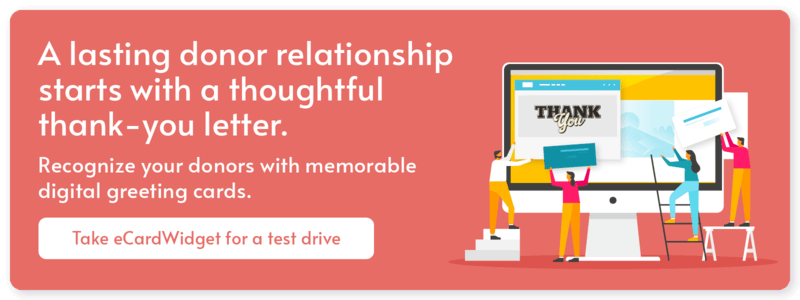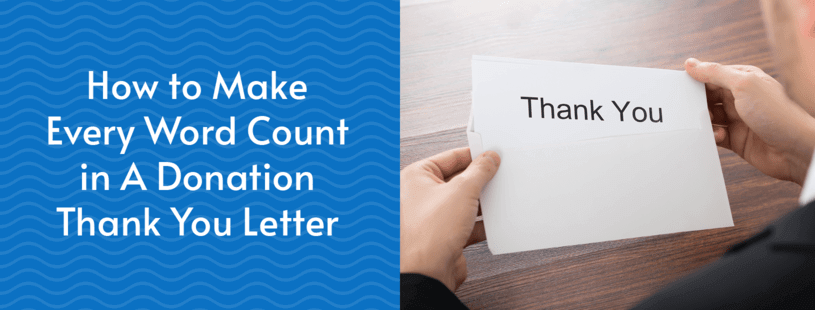
Ever receive a halfhearted “thank you” and feel a tad underappreciated? In the philanthropic world, gratitude can be the bridge between a one-time donor to a lifelong supporter. Going above and beyond with your donation thank you letters will express your genuine gratitude, resonate with your donors, and inspire greater donor retention.
Imagine a donor, moved by your acknowledgment, becoming a passionate advocate for your cause. They’d increase their contributions over time or may even rally their network to support your work. That’s the power of a heartfelt thank-you!
This guide will help you reimagine your approach to donation thank you letters. Explore everything you need to know about crafting impactful donation thank you letters, ensuring every donor understands their generosity’s value. Here’s what we’ll cover:
- Why do donation thank you letters matter?
- Types of donation thank you letters
- The anatomy of a donation thank you letter
- 10 tips for crafting donation thank you letters that resonate
- 3 free donation thank you letter templates
- Using eCards to spice up your donor thank you letters
- Channels to send your donation thank you letters
As a pivotal piece of your donor acknowledgment strategy, mastering donation thank you letters should be at the top of your donor relation team’s priorities. Let’s delve into the essentials, so you can level up your thank-yous.
Why Do Donation Thank You Letters Matter?
An exceptional letter serves as more than a confirmation that your nonprofit received a donation. Here are a few reasons why it’s vital to get your donation thank you letters right:
- Reassure donors they made the right choice. Expressing gratitude will communicate that your nonprofit values each and every donation it receives, no matter its size. Plus, thank you letters give you the chance to outline how you’ll spend donations, assuring donors that your team is transparent and accountable.
- Nurture your relationships. Thanking your donors makes them feel valued and appreciated, making them more likely to continue supporting and making gifts to your nonprofit. After all, the Fundraising Effectiveness Project estimates the recapture rate for lapsed donors is a measly 1%. So if your donors don’t feel appreciated and subsequently stop giving, there’s a slim chance they’ll ever donate again.
- Differentiate your organization. Given that not all organizations send donation thank-you letters, doing so can set your nonprofit apart. This can show an extra level of dedication and appreciation for your supporters.
Not to mention, letters can also make your nonprofit’s communications stand out. For example, you could send your thank you letter along with the donation tax receipt after a donor makes a gift. In any case, thoughtful letters show donors that you’re putting effort into your relationship with them and that you care about making them feel good about their choice to donate to you.
Types Of Donation Thank You Letters
As a development officer, you already know that there are a handful of ways donors can give to your nonprofit. Each one will warrant a different letter that uniquely highlights how the gift will impact your cause.
While we’ll explore donation thank you letter templates later, let’s start by exploring the different types of donations you should acknowledge:
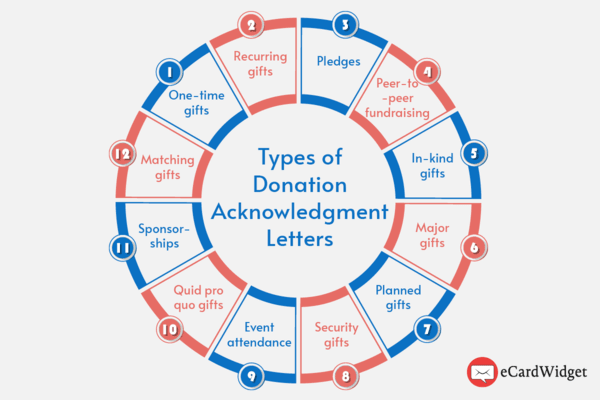
- One-time gifts: Send a heartfelt letter for any donations that meet a certain threshold. Be sure to include a tax receipt.
- Recurring gifts: While some nonprofits stop sending donation thank you letters to recurring donors, continue to acknowledge their contributions with letters. After each acknowledgment, offer periodic updates and highlight the cumulative impact of their ongoing support.
- Pledges: Recognize the donor’s commitment to give with an initial thank-you note. As each installment comes in, send a separate donor thank you letter to acknowledge you received and appreciate it.
- Fundraising: Whether they peer-to-peer fundraise or help run an event, anyone who fundraisers on your behalf should be acknowledged. Send a letter expressing gratitude for the money they raised and for their role as an advocate.
- In-kind gifts: Send a donation thank you letter to individuals or organizations who make in-kind donations, such as venue space or silent auction items. Explain how the non-monetary contribution will benefit your work.
- Major gifts: This level of giving deserves some special care. For donors who give a substantial amount, a templated approach can come across as ingenuine. Instead, have a member of your leadership team craft a handwritten note from scratch. You might even offer a customized impact report to underscore the significance of their contribution.
- Planned gifts: Sincerely thank donors for their forward-thinking generosity when they leave your organization in their will. Be sure to highlight the lasting legacy their gift will have on future beneficiaries.
- Security gifts: Express appreciation for stock and security donations. In your donation thank you letter, emphasize the potential long-term impact on your nonprofit’s financial health and mission fulfillment.
- Event attendance: Thank attendees post-event with a note that emphasizes the importance of their presence in supporting your cause.
- Quid pro quo gifts: The IRS explains that a quid pro quo contribution is “a payment…to a charity partly as a contribution and partly for goods or services.” Let’s say a donor purchases an event ticket from a charity for $100. If it was valued at $60, the charitable contribution part of the payment would be $40 and should be acknowledged with a detailed letter.
- Sponsorships: Proactively thank businesses and other organizations that support your cause with a custom note of appreciation.
- Matching gifts: Send a personalized donation thank you letter expressing appreciation for the donor’s initial contribution and their effort to amplify its impact through a matching gift from their employer. When possible, acknowledge the company that provided the matching gift to strengthen ties with corporate partners.
Any type of donation warrants some form of acknowledgment. As you can tell, you’ll need to take slightly different approaches to properly address these different types of gifts, too.
The Anatomy of A Donation Thank You Letter
Even if you’re not a professional writer, you can still craft a meaningful letter. That all starts with knowing the fundamental components. You’ll notice each donor letter template we share later includes these elements. Even if you adapt the templates or start from scratch, ensure these fundamentals are still present.
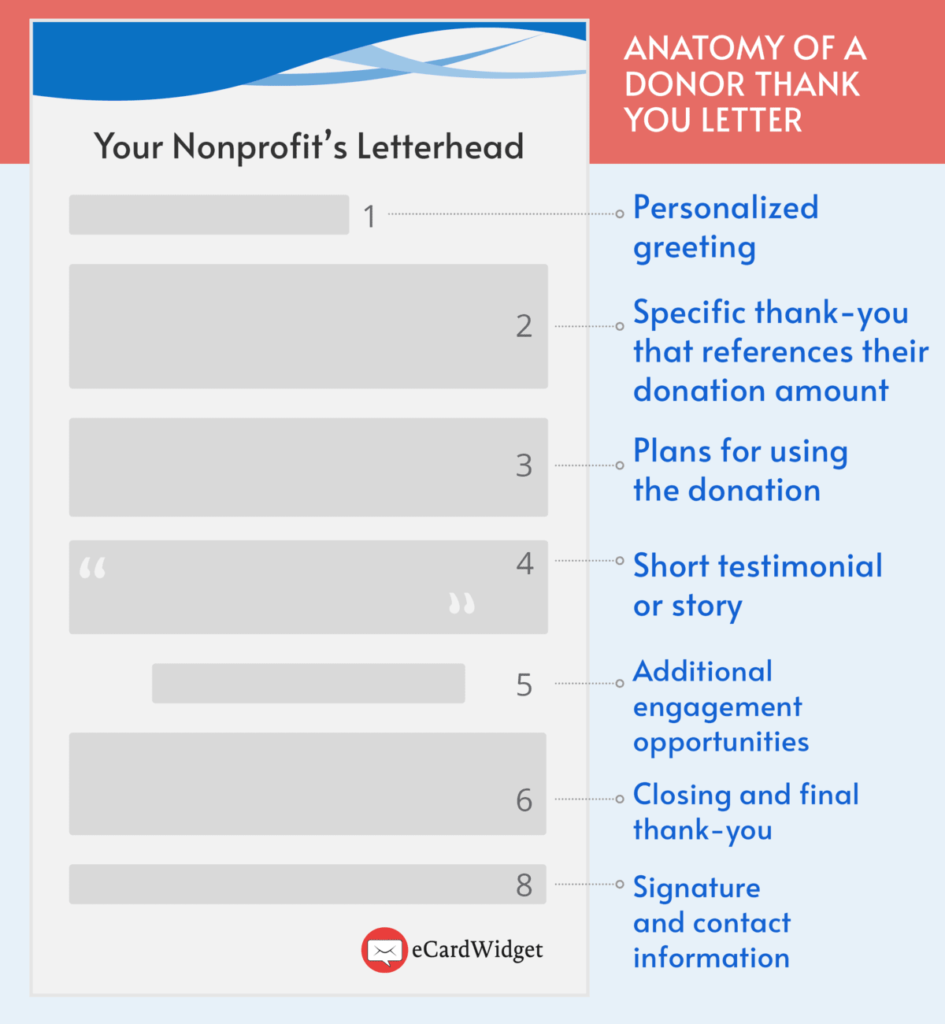
The Salutation and Introduction
Catch your donor’s attention right off the bat with your introduction. You’ll want to address the donor by name and preferred title, rather than a generic “Dear donor.” This increases the authenticity of your donation thank you letter instantly.
Somewhere in your introduction, include their donation amount as a reminder of how much they gave and how it impacted your cause, no matter how much or little they gave. Consider mentioning other recent contributions or interactions they’ve had with your team. Overall, this part of your letter sets the tone, so give it the care it deserves by personalizing it however you can.
The Body
In this section, dive into the donation’s impact. Remember, the letter is about the donor, not your nonprofit. Use donor-centric language, and emphasize how you’ve used or will use the donor’s contribution to further your cause. If they’ve given before, reference their past contributions and explain what those have helped you achieve.
If you have a short story or testimonial from a beneficiary available, include that here to really drive your point home.
The Conclusion
Reiterate your gratitude one final time and encourage the donor to continue their relationship with your cause. The end of your donation thank you letter provides the opportunity to include an additional call to action.
Don’t ask for another donation. Rather, give them a meaningful way to engage with your cause, whether you want them to:
- Share your cause with others
- Sign up for your mailing list
- Register for a volunteer opportunity
- Join your membership program
In any case, your conclusion should leave a good taste in their mouth and end on a high note. Be sure to share contact info for any questions or feedback. Then, include a signature from a real person at your organization, whether that’s the fundraising director, executive director, or someone else.
10 Tips for Crafting Donation Thank You Letters That Resonate
It’s easy to fall into the routine of producing cookie-cutter donor thank you letters. However, donors will start to take notice, especially if they get the same letter slightly tweaked from the last one they received. Instead, go above and beyond by putting these tried-and-true tips into practice.

Use donor-centric language.
When writing your donation thank-you letters, focus on showing your gratitude and recognizing the support your donor has given you. Use a warm, friendly, and conversational tone—imagine talking to a friend. Then, adopt that tone in your writing. This will help your donors feel closer to your nonprofit and result in stronger relationships.
Make it a point to emphasize their role in your success with donor-centric language, which means using “you” more often than “we/us.” Examples phrases you can use to adopt this tone include:
- “Because of you…”
- “Your generosity has transformed the lives of…”
- “Your commitment has directly impacted…”
- “Because you cared, we achieved…”
- “Your belief in our mission has enabled…”
Also, resist the temptation to overeducate your donor on your nonprofit’s cause and activities. This information will likely be redundant, as most donors will have done their research on your nonprofit before deciding to support you.
Demonstrate concrete impact.
Donors want to know how their gifts are being used and how they’ve helped impact the world. In your donor thank you letters, demonstrate concrete impact by mentioning tangible goals and outcomes you’ve achieved or hope to achieve. Here’s a quick example:
Your generous gift of $50 to our food bank will help feed a family of four for a week.
For best results, weave anecdotes with data. Choose a beneficiary to focus on and tell their story and how donations will help them. Then, back the anecdote up by providing statistics to prove your impact. By combining the two, you’ll appeal to your donors’ emotions and reasoning, resulting in a greater understanding of the change you’re driving.
Personalize your donation thank you letters.
Everyone wants to feel special, and donors are no exception. NXUnite’s guide to donor recognition shares these ways you can personalize your donation thank you letters:
- Use the donor’s first and last name.
- Mention the specific amount donated and any previous donations.
- Reference your donors’ engagement history (e.g., events, volunteering, etc.).
- Bring awareness to their employer’s matching gift program, if they have one.
With personalized thank you letters, your donors will feel that you are genuinely interested in connecting with them. Bringing up their volunteer history and the other ways they’ve supported your organization shows them that you value them outside of their monetary gifts.
Be concise.
While you may want to spend pages and pages explaining to donors how much you appreciate them and what they’re helping your nonprofit achieve, your donors are busy people. Keep your letter short and sweet so that donors can quickly move on with the knowledge that you value them. A few paragraphs will suffice!
Use images and graphics.
Images can break up text and provide visual appeal. You can use effective graphic design to include infographics and photos of beneficiaries and volunteers in your donation thank-you letters to share visually-engaging details with curious donors. Make sure that the images are well-composed and high-definition. Additionally, if your thank-you letter is electronic, your images should be optimized to look good on both desktops and mobile devices.
Offer additional engagement opportunities.
By making a gift to your nonprofit, donors have demonstrated their interest in your cause and your success. This means that they might be open and willing to connect with you in other ways as well. Take the initiative and invite them to fundraising events, inform them about volunteer opportunities, and ask them if they’d like to opt-in to your nonprofit’s newsletter.
Send it promptly.
To ensure that your donor feels appreciated, send your thank you letter within 24-72 hours of their gift. Promptness ensures a few things:
- Donors know you received their donation.
- Donors recognize you prioritize efficiency and value supporter relationships.
- Your cause stays fresh in the donor’s mind, fostering a deeper connection.
Ideally, you should send a donation tax receipt almost immediately after a gift has been made, and you can use that opportunity to include a donation thank you letter. Alternatively, send a quick thank-you text and follow up later with a longer email or eCard letter.
Infuse real stories.
By incorporating stories and testimonials from beneficiaries into your donor acknowledgment letters, you can transform a generic message into a powerful narrative. Donors will feel emotionally connected to their impact, so it’s crucial you know how to weave stories into your letters. Here’s how you can do exactly that:
- Use specifics. Provide detailed accounts, like names (with consent), places, and events, which make the story more authentic.
- Provide testimonials. Include direct quotes from beneficiaries, volunteers, or staff members who’ve witnessed the change made possible through donations. These firsthand accounts can resonate deeply with donors.
- Add visual components. Incorporate photographs of the people or communities your nonprofit has impacted. A picture can tell a story more powerfully than words alone. Even better, nonprofit videos can bring stories to life. Just ensure you have consent to use any multimedia you include.
To see some of these strategies in action, watch this appreciation video from University at Buffalo in which scholarship recipients share their sincere gratitude for donors’ generosity:
Incorporating stories and testimonials like this can humanize the impact of a donor’s contribution. In doing so, you’ll move beyond statistics and numbers, reminding donors of the real people and communities they’re helping.
Encourage them to check their matching gift eligibility.
Did you know that more than 26 million people work for companies with matching gift programs? However, 78% of donors are unaware if their company offers one of these programs, according to fundraising research.
Your donation thank you letters are the perfect opportunity to encourage donors to check their eligibility. Highlight the basics of these programs, explaining that they can make their donations go twice as far. If you’ve determined that they’re eligible for their employer’s program, give them the next steps they need to secure a match.
Have beneficiaries write thank-you letters
Your donors expect to hear “thank you” from your team, but what about your beneficiaries? Leverage the emotional connection between donors and beneficiaries by allowing them to write thank-you messages themselves. Here’s how you can facilitate the thank-you letter-writing process:
- Promote the program to beneficiaries and collect signups. Promote the program via word of mouth and email to your most enthusiastic beneficiaries. Don’t forget to set a deadline for signups so you can get thank-you letters out in a timely manner.
- Match beneficiaries with a donor. To maintain your donors’ privacy, only give your beneficiaries the donor’s first name (and vice-versa).
- Provide beneficiaries with letter-writing resources. This can include materials, such as paper, pens, and envelopes, as well as letter templates and other writing tips.
- Coordinate drop-off and sending. Make participating in this program as easy as possible for beneficiaries by sending the letters yourself. Ask beneficiaries to drop off the letters at your office where you can proofread, seal, and send them.
Remember that your beneficiaries are deeply touched by your nonprofit’s work, and by extension, your donors’ generosity. Matching them and allowing beneficiaries to express their gratitude allows them to build a relationship with your donors and empowers them to share their stories in their own words.
3 Free Donation Thank You Letter Templates
Writing a donation thank you letter can be challenging, especially if you’ve never written one before. Whether this is your first letter or you want to reimagine your current approach, these donation thank you letter templates will get the job done.
Feel free to revise these templates to be more or less formal based on your nonprofit’s voice and brand. Also, adapt them to suit each recipient, different types of donations, and the method by which you’re delivering your letter.
General Donation Thank You Letter Template

Hello [donor’s first name],
Thank you for your donation of [amount] to [nonprofit’s name]! We’re so grateful that you’ve chosen to support us and our mission to [your mission/cause]. With generous donations like yours, we’re able to continue working towards a [goal of nonprofit, e.g., world free of hunger].
Your donation will go toward [goal of fundraising campaign]. [Describe how this goal is important to your nonprofit’s mission, include specific actions you’re taking, and highlight how donations will help you take these actions].
We deeply appreciate your commitment to helping [nonprofit’s beneficiaries], and we’ll stay in touch with you about the progress of your gift. If you’d like to stay connected, [inform the recipient about connection opportunities such as subscribing to a newsletter, attending an upcoming fundraising event, etc.].
Thank you for supporting [nonprofit’s name]—we truly wouldn’t be able to make the change we want without help from donors like you.
Warm wishes,
[Your name]
[Your role]
[Contact information]
First-Time Donor Thank You Letter Template

Dear [donor’s first name],
We are thrilled to welcome you to the [nonprofit’s name] community! From all of us here, a heartfelt thank you for your generous donation of [donation amount]. As a first-time donor, your support signals a shared commitment to [specific cause or mission].
Your contribution is already making a difference. [Insert a brief, specific story about someone impacted by donations].
It’s moments like these – made possible by your generosity – that drive us to continue our work every day.
Stay connected! We would love to keep you updated on how your donation is being put to use and the difference you’re making. If you haven’t already, follow us on [social media platforms and usernames] or sign up for our monthly newsletter.
Once again, thank you for choosing to support [nonprofit’s name]. Together, we can [reiterate mission or outcome].
With deepest gratitude,
[Your name]
[Your role]
[Contact information]
Long-Time Donor Thank You Letter Template
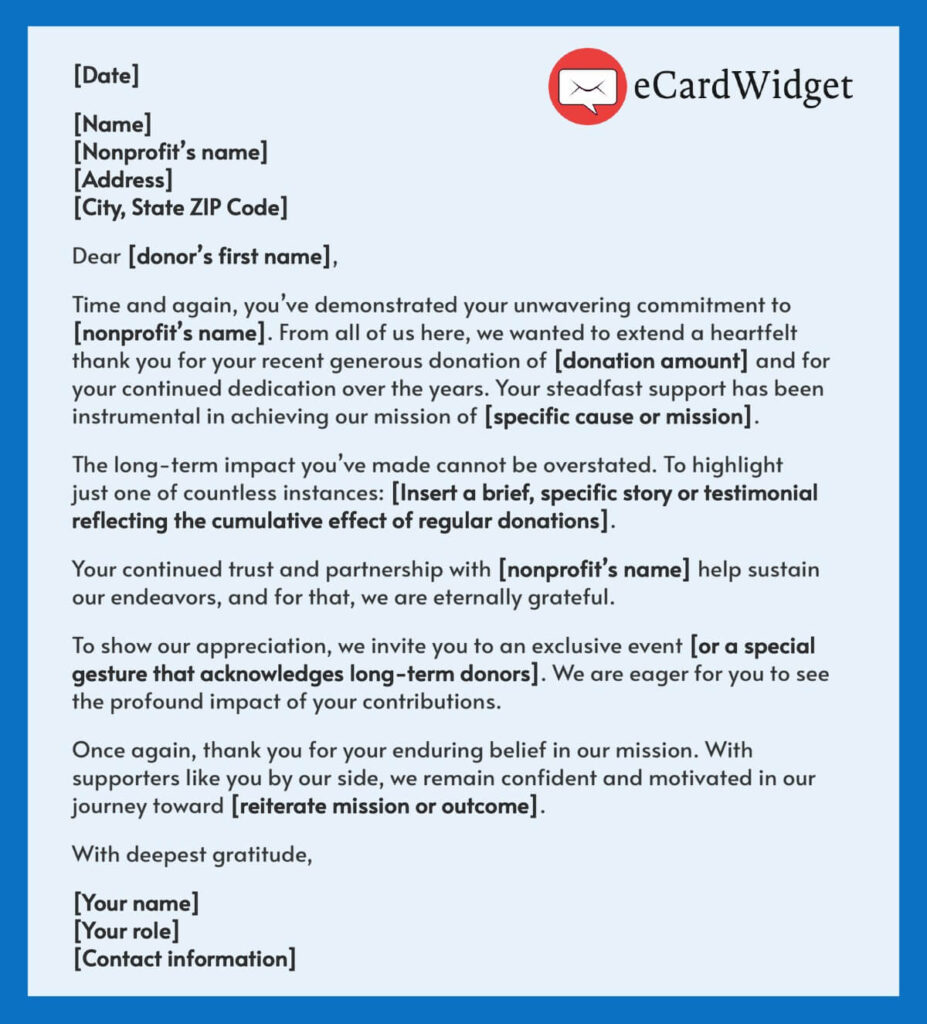
Dear [donor’s first name],
Time and again, you’ve demonstrated your unwavering commitment to [nonprofit’s name]. From all of us here, we wanted to extend a heartfelt thank you for your recent generous donation of [donation amount] and for your continued dedication over the years. Your steadfast support has been instrumental in achieving our mission of [specific cause or mission].
The long-term impact you’ve made cannot be overstated. To highlight just one of countless instances: [Insert a brief, specific story or testimonial reflecting the cumulative effect of regular donations].
Your continued trust and partnership with [nonprofit’s name] help sustain our endeavors, and for that, we are eternally grateful.
To show our appreciation, we invite you to an exclusive event [or a special gesture that acknowledges long-term donors]. We are eager for you to see the profound impact of your contributions.
Once again, thank you for your enduring belief in our mission. With supporters like you by our side, we remain confident and motivated in our journey toward [reiterate mission or outcome].
With deepest gratitude,
[Your name]
[Your role]
[Contact information]
Using eCards To Spice Up Your Donor Thank You Letters
Sending an eCard as a donor thank-you letter is an easy way to more deeply engage with your donors. Here are some benefits of using eCards for your donor thank-you letters:
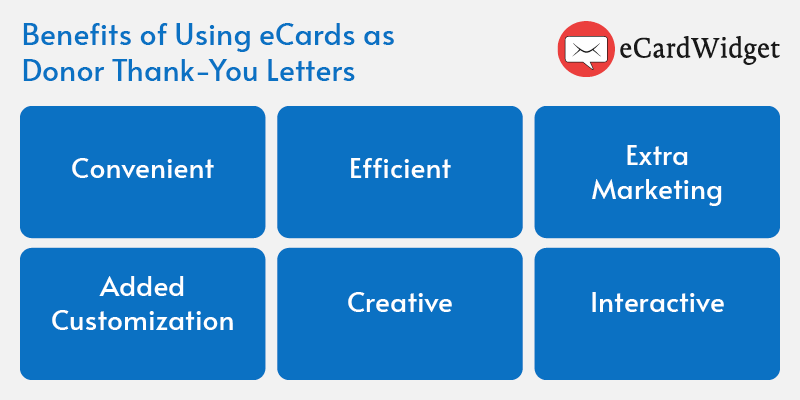
- Convenient. You can integrate your CRM with eCard software and schedule sending eCards to donors who made a gift within the last 48 hours.
- Efficient. Donors will receive your eCards almost immediately after you send them. Additionally, you won’t need to pay for printing materials and stamps like you would for a typical direct mail letter.
- Extra marketing. With social media integration, donors can share the eCards they receive on their social media pages, essentially helping you promote your nonprofit’s cause. This allows you to reach individuals that might not otherwise have come into contact with your nonprofit.
- Added customization. eCards are very customizable, allowing you to choose what images to use, what text to include, and what font that text will be in.
- Creative. Sending eCards to your donors gives you the opportunity to show your nonprofit’s creativity and to connect with your donors in a fun way.
- Interactive. eCards aren’t limited to just text and images. You can add animations or little videos as well. For example, check out Teremana’s animated Valentine’s day eCards and notice how their designs used GIFs.
Using eCards doesn’t mean sacrificing the text and meaning behind your letters—much like a physical greeting card, you can include a message alongside the card image.
To create compelling eCards, partner with an eCard software solution such as eCardWidget, which offers many features, including multi-language support, customizable email templates, and read receipts. Here’s an overview of how you can create your eCards to level up your donor recognition:
Sending your donation thank you letters as eCards is a fantastic way to take your outreach up a notch. Plus, we even offer templates to kickstart the design process!
How eCards Transformed One Nonprofit’s Appreciation
Curious how this approach looks in practice? We have a real-world example for you! Youth for Understanding took an innovative approach to its supporter appreciation with eCards. In honor of its 70th anniversary, the nonprofit launched an eCard campaign in which past program participants could thank their friends, host families, teachers, volunteers, and anyone who made their experience memorable.
The sender could pick one of the artfully designed thank you cards below and customize a message to be sent alongside it. From here, the eCard was delivered using email, Facebook, or whichever platform they preferred.

It was a great way for beneficiaries to reconnect and make individuals realize the impact of their support. When thinking about your donation thank you letters, you might try this approach by allowing beneficiaries to send eCards to donors.
Channels To Send Your Donation Thank You Letters
So you’ve crafted a donation thank you letter you’re proud of. Now, how do you deliver it to the recipient? It’s no secret that donors lead busy lives, so you need to reach out using the channels that are most likely to catch their attention.
Start by looking at the donor’s preferred contact method. You may even consider sending your letter via more than one channel. After all, marketing campaigns that use direct mail and one or more digital channels experienced a 118% increase in response rate compared to direct mail only.
Here are the most common methods you can use to deliver your donation acknowledgment letters:
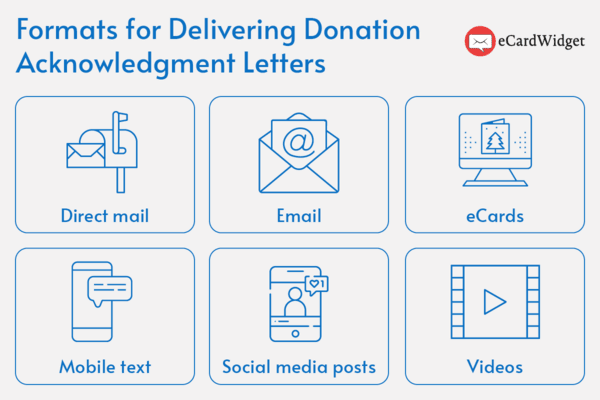
- Direct mail. The classic donor thank-you letter is a physical note mailed to supporters. Handwrite yours for some extra personalization so donors can concretely see the effort you’re making for them.
- Email. Email thank-you letters are similar to physical ones sent through direct mail, but they are faster, more convenient, and more cost-effective. Plus, the average nonprofit email open rate is 28.59%, making it a reliable way to deliver letters. You can even automate thank-you emails through your CRM.
- eCards. Formatting your letters as online greeting cards will transform them into unique donor thank-you letters that can be very engaging and effective. This approach is especially effective when you customize the design around holidays such as Valentine’s Day. Use a fun and high-quality image for your eCard and add a heartfelt thank-you to make it a great letter to your donors.
- Mobile text. Texts have an average open rate of 98% and a response rate of 45%. When you acknowledge donors via text, these letters tend to be shorter and more along the lines of a quick thank-you. To effectively use mobile text letters, send automated ones immediately after a donor makes a gift. Later on, follow up with a longer letter, such as an email.
- Social media posts. Since social media posts are visible to everyone who views your page, these letters tend to be more general and not specific to a single donor. However, writing a social media shoutout to a major donor can be a meaningful way to show your appreciation for someone who has made a big impact on your nonprofit.
- Video. As another untraditional donor thank-you letter, videos are an entertaining way for you to convey your gratitude to your donors. They take a lot of effort to film and edit, but when done well, donors recognize and appreciate this effort. For bonus points, include footage of your beneficiaries so that donors know who their funds are supporting.
Each method for delivering your donor thank you letters has its own unique benefits and drawbacks. You’ll want to use channels that work best for your nonprofit and donors. Consider demographics—if your donors are mostly older individuals, they might appreciate physical letters sent to them via direct mail. On the other hand, if your donors are younger and belong to Generation Z, they might be more inclined to interact with social media and eCards.
Signing Off With Gratitude: Final Thoughts on Donor Acknowledgment
Donor thank-you letters are a crucial part of stewarding your nonprofit’s donors. Establish a clear strategy for your letters and consider ways you can make them stand out, such as by creating video or eCard letters. Aside from making great donor thank-you letters, eCards can also benefit your nonprofit by being used for fundraising purposes or for event invitations.
If you’re interested in learning more about how eCards can benefit your organization, take a look at some of these resources:
- Charity eCards: How to Create Cards That Make A Difference. Read about how charity eCards can support your nonprofit outside of donor thank-you letters.
- Birthday Fundraisers: How to Secure Year-Round Support. Birthday fundraisers are a unique way for nonprofits to make connections with donors. Learn more about how you can leverage eCards for them.
- Nonprofit Christmas Fundraising Ideas for Holiday Giving. This guide goes over popular Christmas fundraising ideas to inspire your nonprofit’s year-end efforts.
